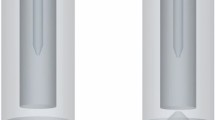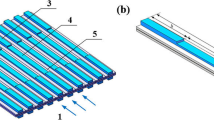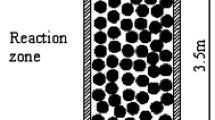Abstract
Various design configurations of semi-T-shaped dual-channel micro-reactors were numerically examined for their laminar mass transport performance in heterogeneous catalytic combustion of methane and air. One single-channel and five dual-channel configurations (i.e., parallel, divergent, convergent, zig-zag, and curved configurations) were investigated with a two-dimensional computational fluid dynamics model. These innovative design configuration were compared in terms of CH4 utilization, pressure drop, CO/CO2 ratio, catalyst utilization, and a performance index at various Reynolds numbers. Dual-channel micro-reactors were found to enhance mass transport due to the well mixed flow and the increased reaction contact area. By suitably modifying the dual-channel layout angle and shape, recirculation zones can be formed within the reactor which increase CH4 utilization. However, the improved conversion rate is achieved at the cost of high pressure drop. The parallel dual-channel design provides the highest conversion per unit pressure drop over the range of the Reynolds numbers studied. For Reynolds numbers of 20 and 40, compared to the single-channel micro-reactor, divergent, convergent and curved channel designs yield higher conversion per unit pumping power. However, further increase of Reynolds number (i.e., 60, 80, and 100) deteriorates their performance due to the significantly increased pressure drop and shorter residence time.
















Similar content being viewed by others
Abbreviations
- Ar :
-
pre − exponential factor
- B i :
-
bulk/solid species, mol
- \( {b}_i^{\hbox{'}},{b}_i^{\hbox{'}\hbox{'}} \) :
-
stoichiometric coefficient for bulk reactant, and product
- c p :
-
specific heat, J · kg−1K−1
- Di :
-
diffusivity of species i, m · s−2
- E r :
-
activation energy for the reaction, J · kg · mol
- Gi :
-
gas species, mol
- \( {g}_i^{\hbox{'}},{g}_i^{\hbox{'}\hbox{'}} \) :
-
stoichiometric coefficient for gas reactant, and product
- keff :
-
effective thermal conductivity, W · m−1K−1
- kf, r :
-
reaction rate constant using Arrhenius expression
- M :
-
mean molecular mass
- \( {\dot{m}}_{\mathrm{dep}} \) :
-
net rate of mass deposition, kg
- p :
-
pressure, pa
- Q :
-
volume flow rate, m3 · s−1
- R :
-
universal gas constant, J · kg‐1 · mol‐1 · K‐1
- R i :
-
reaction rate of species i, kg · m−3
- Si :
-
surface ‐ adsorbed/site species, mol
- \( {s}_i^{\hbox{'}},{s}_i^{\hbox{'}\hbox{'}} \) :
-
stoichiometric coefficient for site reactant, and product
- S temp :
-
heat release/absorb due to reactions, W · m‐3
- T :
-
temperature, K
- u :
-
velocity, m · s−1
- x :
-
mole fraction
- βr :
-
temperature exponent
- ρ :
-
density, kg · m−3
- μ :
-
dynamic viscosity, K · g · m‐1 · s‐1
- ℜ :
-
rate of rth reaction
- η pump :
-
pump efficiencey
- ωi :
-
mass fraction of species i
- b:
-
Bulk
- dep:
-
Deposition
- eff:
-
Effective
- g:
-
Gas
- i:
-
Species i
- r:
-
rth wall surface reaction
- r,in:
-
Reactant at inlet
- r,out:
-
Reactant at outlet
- s:
-
Solid/site
- temp:
-
Temperature
References
Pan J, Zhang R, Lu Q, Zha Z, Bani S (2017) Appl Therm Eng 117:1
Yang WM, Chua KJ, Pan JF, Jiang DY, An H (2014) Energ ConversManag 78:81
Yao X, Zhang Y, Du L, Liu J, Yao J (2015) Renew Sust Energ Rev 47:519
Zuo W, J E, Han D, Jin Y (2017) Energ ConversManag 150:343
Aghel B, Rahimi M, Sepahvand A, Alitabar M, Ghasempour HR (2014) Energ ConversManag 84:541
Dai Z, Fletcher DF, Haynes BS (2015) Int J Heat Mass Transf 83:382
Jensen KF (2001) Chem Eng Sci 56:293
Shaker M, Ghaedamini H, Sasmito AP, Kurnia JC, Jangam SV, Mujumdar AS (2012) Chem Eng Process 54:1
Lu Z, McMahon J, Mohamed H, Barnard D, Shaikh TR, Mannella CA, Wagenknecht T, Lu T-M (2010) Sensors Actuators B Chem 144:301
Mohan B, Puqing J, Sasmito AP, Kurnia JC, Jangam SV, Mujumdar AS (2014) Ind Eng Chem Res 53:18699
Cheng Y, Jiang Y, Wang W (2018) Chem Eng Process 127:93
Rosinha Grundtvig IP, Daugaard AE, Woodley JM, Gernaey KV, Krühne U (2017) Chem Eng J 322:215
M. Rahimi, B. Aghel, B. Hatamifar, M. Akbari, A. Alsairafi, Chem. Eng. Proces 2014, 86, 36
Chen B, Li G, Wang W, Wang P (2015) Appl Therm Eng 88:94
Liu D, Ling X, Peng H (2016) Adv Mech Eng 8:1687814016637329
Liu Z, Guo L, Huang T, Wen L, Chen J (2014) Chem Eng Sci 119:124
Hossain S, Ansari MA, Kim K-Y (2009) Chem Eng J 150:492
Rostami AA, Mujumdar AS, Saniei N (2002) Heat Mass Transf 38:359
Rabani R, Talebi S, Rabani M (2016) Heat Mass Transf 52:619
Gorasiya A, Saha AK (2019, in press) Heat Mass Transf. https://doi.org/10.1007/s00231-018-2419-y
Fazeli A, Behnam M (2010) Int J Hydrogen Energ 35:9496
Sasmito AP, Kurnia JC, Mujumdar AS (2012) Ind Eng Chem Res 51:1970
Kurnia JC, Sasmito AP, Mujumdar AS (2011) Appl Therm Eng 31:1293
An H, Li A, Sasmito AP, Kurnia JC, Jangam SV, Mujumdar AS (2012) Chem Eng Sci 75:85
Ortega-Casanova J, Lai C-H (2018) Chem Eng Process 125:163
Ansari MA, Kim K-Y (2010) Chem Eng J 162:760
Bawornruttanaboonya K, Devahastin S, Mujumdar AS, Laosiripojana N (2017) Int J Heat Mass Transf 115:174
Chen Y-T, Chen K-H, Fang W-F, Tsai S-H, Fang J-M, Yang J-T (2011) Chem Eng J 174:421
Alam A, Kim K-Y (2013) Sensors Actuators B Chem 176:639
Bond TG, Noguchi BA, Chou C-P, Mongia RK, Chen J-Y, Dibble RW (1996) Symp Combust 26:1771
Canu P (2001) Catal Today 64:239
Author information
Authors and Affiliations
Corresponding author
Ethics declarations
Conflict of interest
The authors declared that there is no conflict of interest.
Additional information
Publisher’s note
Springer Nature remains neutral with regard to jurisdictional claims in published maps and institutional affiliations.
Rights and permissions
About this article
Cite this article
Li, J., An, H., Sasmito, A.P. et al. Performance evaluation of mass transport enhancement in novel dual-channel design of micro-reactors. Heat Mass Transfer 56, 559–574 (2020). https://doi.org/10.1007/s00231-019-02727-6
Received:
Accepted:
Published:
Issue Date:
DOI: https://doi.org/10.1007/s00231-019-02727-6




